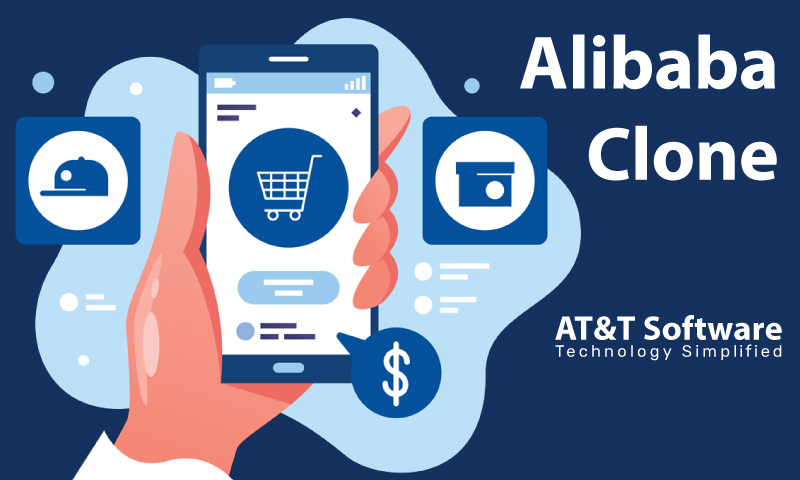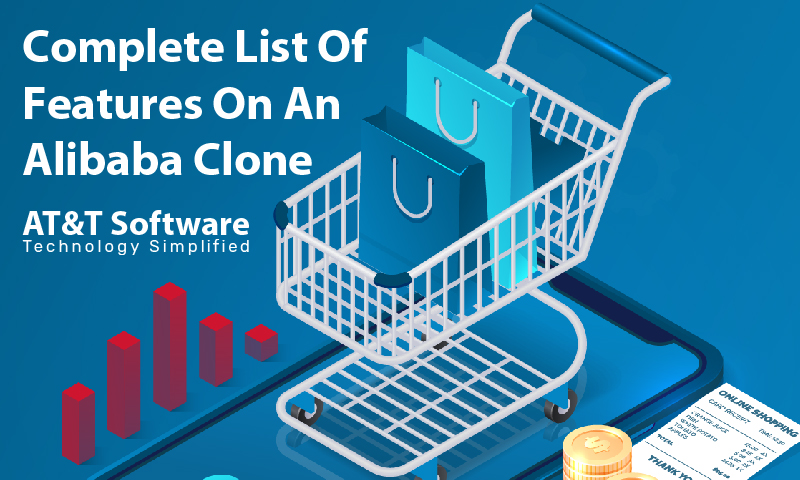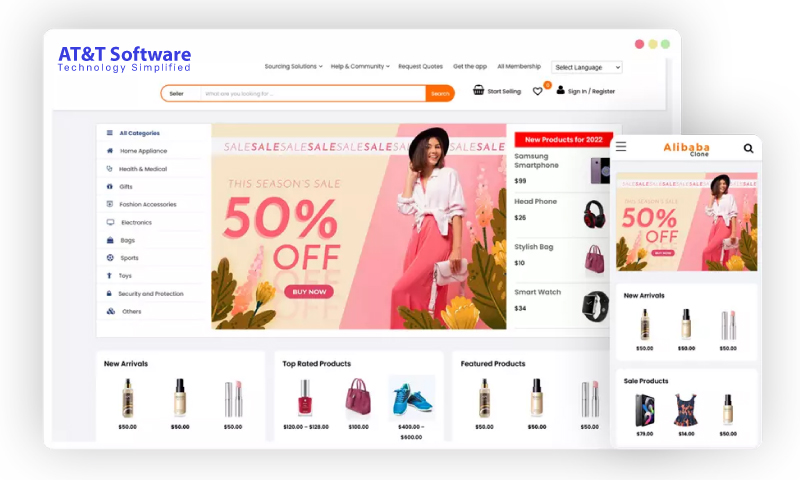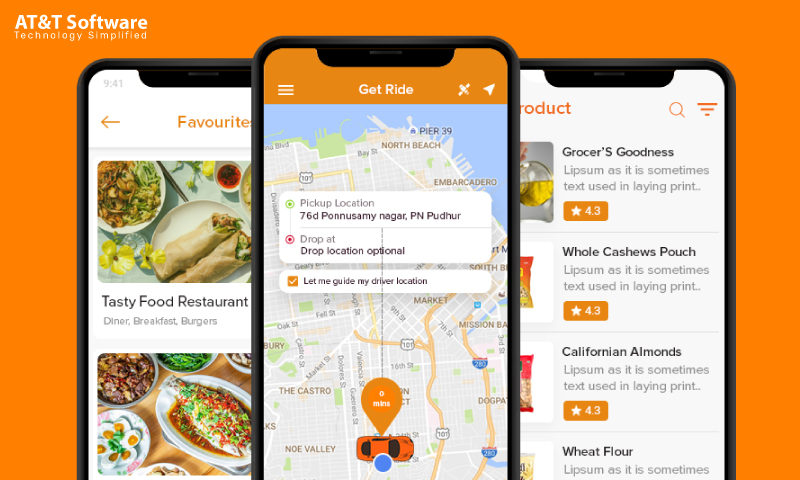Alibaba Clone- Step-By-Step Workflow
home / blog / Alibaba Clone- Step-By-Step Workflow

The Alibaba Clone is an eCommerce platform that supports B2B, B2C, and C2C services opportunities and options. It enables buyers and sellers to engage in trade and business most conveniently. The platform is a budding ground for sellers to connect with buyers and get the correct value for the product. The customer also gets their due by getting everything they want in one place.
The initial hurdle is to illustrate a complete workflow with steps to build an eCommerce platform offering a range of services to its users. This is the groundwork that you will have put it, based on which the entire eCommerce portal will be built upon. We have broken down the workflow into 5 steps in the following section.
Step1: For utilising the services of any eCommerce app or web portal of the time, the user is mainly asked to register. For the buyer, the process is relatively easy, with them having to verify their i.d and other credentials. At the same time, the seller has to enter their credentials plus upload documentation, especially a trade licence.
Step2: On successfully entering the Alibaba Clone platform, the seller can post items that they have in store for sale with accurate detail and pricing. On the other hand, the buyer will be able to skim through the platform and find things that they find attractive. They use the search option to type or voice out the product’s name or the seller’s name for searching specific items.
Step3: On finding the product that the buyer wants to purchase, they can add it to the cart. They can check the product details, pricing, and delivery details, all jotted down in the cart. The buyer can also save up a product that they want to buy at a later time, marking it as a favourite. However, the products saved under the favourite section are susceptible to changes.
Step4: The cart section on the Alibaba Clone will also have checkout. When the buyer proceeds to checkout, they are immediately directed to the payment gateway. If they wish to pay then and there through online means, they will need to add their bank accounts or debit/credit cards to process the transaction. The platform could also contain cash-on-delivery features, in which case, the buyer can pay once they receive the product on their hand.
Step5: Lastly, as the delivery progresses, the buyer and the seller can track the delivery person and their activity on the road. With a GPS tracker, they can know their exact location and may even guide if required. The buyer will receive the package at the right place and right time.
Complete List Of Features On An Alibaba Clone

The features displayed on an Alibaba Clone are determined at the start of the whole process. After that, the entire development process further adds a revenue model, and you have got your online marketplace ready for launch. So without further ado, let us check out the complete list of features that will make your app stand out in specific ways.
Alibaba Clone Feature For The Buyer’s Panel

To start on the features list, we will first have to sort out the different participants using the platform and its services. For a typical eCommerce platform, three to four participants are usually involved in making the whole process work. The admin, the seller and the buyer are three stable candidates, while the platform could also have a delivery fleet of its own, incorporating the fourth member. We will be talking about the primary three, starting with the features of the buyer’s panel of the Alibaba Clone.
Easy Onboarding
The buyers are the most prominent bread earners for the seller and the platform. Without their urge to buy, the whole business scheme would die out in vain. Hence, onboarding must be made more accessible to catapult more audiences. Usually, email i.ds, phone numbers, or social media handles are required for registration, verified on the ground.
Browsing Products
The buyer is immediately assorted with an account with very few minimal credential verification. After logging into this account, the user can check out the various products and services offered under the platform. It will have a search bar for type searches and may even have a voice search feature to make it more engaging.
Add To Favorites
When the buyer comes across any product on the Alibaba Clone platform that they wish to buy sometime soon, they can mark it as a favourite. This is especially important when the buyer has a shortage of money but still cannot let it go; they can save it for later. The items saved under the favourite panel can go out of stock or through a change of pricing and other matters that could affect the purchase when the buyer is ready.
Add To Cart
Contrary to the favourite option, when the buyer is ready to pay and buy an item, they can add it to the cart. The cart will contain all details that the buyer needs to know before purchasing. For example, a breakdown of the total price, product details, delivery details and other info will be presented in the cart.
Proceed To Checkout
Once the buyer has gone through the cart, checking out all the necessary details, they can proceed to checkout if they still wish to buy the product. The Alibaba Clone will have multiple payment options that the buyer can choose from.
In-App Chatting
A virtual place conducting trade and business needs a communication panel where the buyer and seller can come to terms with certain things before engaging in business. In-app chatting is the best way to achieve this feat singlehandedly. They discuss any problem, queries the buyer has or negotiate around price if possible.
Invite Friends
The platform has a few strategic features planned for expanding its reach through its clients. One option is inviting friends. Social media integration can boost your platform’s reach. In addition, friend invites can be made interesting by attaching a reward system.
Purchase History
An Alibaba Clone has to save and store all data and records of the transactions and activities over the platform. Every buyer can access their purchase history from this web of data. The purchase history contains all the data of every purchase that the buyer has actively participated in.
Ratings & Reviews
After the buyer has used the services, they are asked to rate and review their experience. This is for the platform to know where they can improvise, and the sellers can now understand the customers’ demands. These ratings and reviews are publicly posted over the platform for others buyers to have a distinct idea about products and services.
Alibaba Clone Features For The Seller’s Panel

The counterpart of the buyer is the seller, and the panel features are also crafted in the same pattern. However, a few features for the seller’s panel are instrumental for the functioning of the Alibaba Clone. Keeping these a priority, we have listed the most crucial features below for the seller’s panel.
Registration
Like the buyer, the seller is also required to register. However, the seller’s registration process is a bit complex. Apart from getting their usual credentials verified, they will also have to go through document verification for authentication.
Profile Set-Up
Once the documentation is verified, the seller will immediately be provided with a profile. This profile will have to be set up by the seller, with all the necessary detail and info about them and their service or products. They can also add any achievements and awards received by their team to solidify their reputation further.
Availability Toggle
The seller of the Alibaba Clone has the agency of working only when they want to. Even though we are at the age of 24*7 service availability, that doesn’t mean those services are non-stop run; they will have alternative panels. The availability toggle button has a similar ideology, allowing the seller to turn off their services.
Order Management
The filter for every order request is the seller themselves; hence they are responsible for taking personal time out for each approval or decline. They have to state the reason for declining an order; otherwise, they are good to go. They can set up the order dates and schedule them at their convenience.
Product Management
Similarly, the seller also needs to manage the products they have listed by themselves. The entire Alibaba Clone product list or categorisation depends on how individual sellers present their products to the platform. They can manage the demand by informing customers when the product runs out of stock or is back in stock, changes in price and other similar factors.
Sold Product History
The seller also needs to have a good list of all the successful sales of their products. This list is important for keeping track of their business at the forefront.
Conclusion

Developing both a website and an application is essential to tackle the digital world and have a vast reach through the internet. Therefore, the Alibaba Clone app should be mobile-friendly and compatible with Android and iOS devices. At the same time, the website should be made to support all computer-based devices and include a mobile view.

I hope you enjoy reading this blog post.
Would you like to get expert advice? Schedule a Call
About Webrock Media
Webrock Media comes with an incredible team of website and mobile application developers who can customize the perfect solutions to transform your business. We think ourselves to be an ideal ‘Technology Simplified Destination’ as we know how to perfectly merge creativity and programming to build robust websites for our clients.
